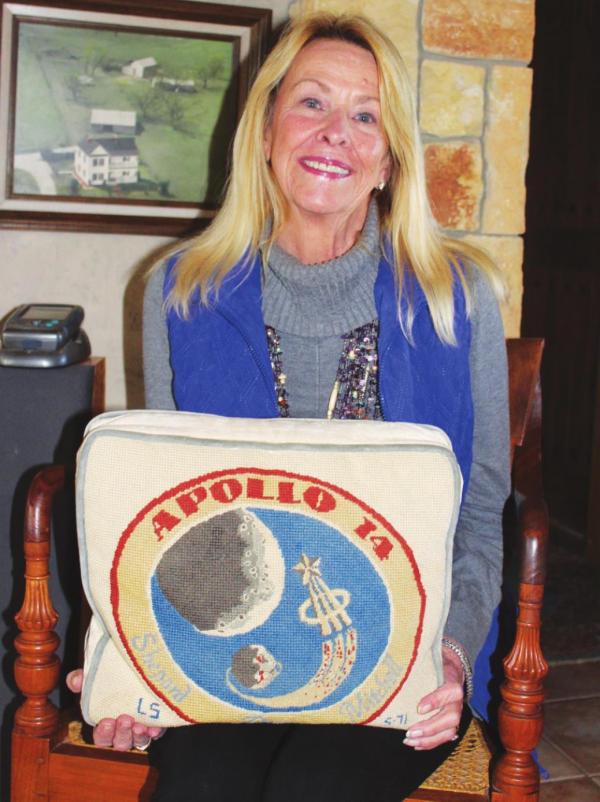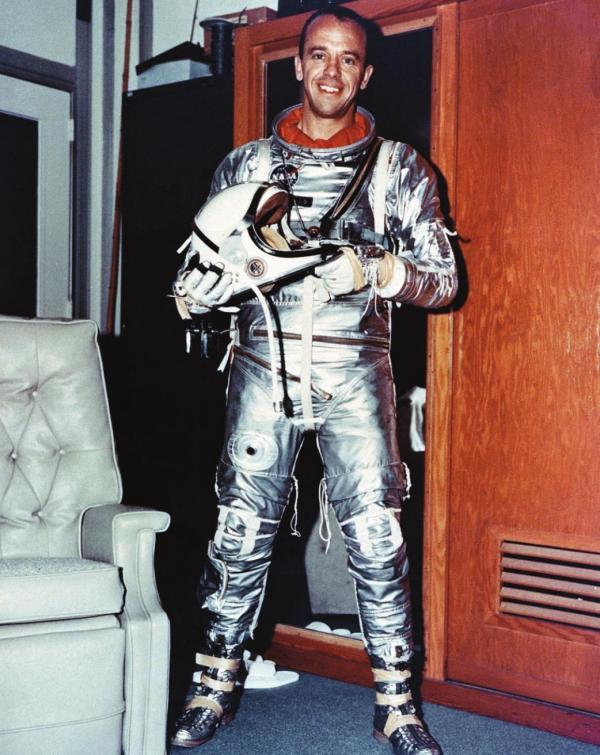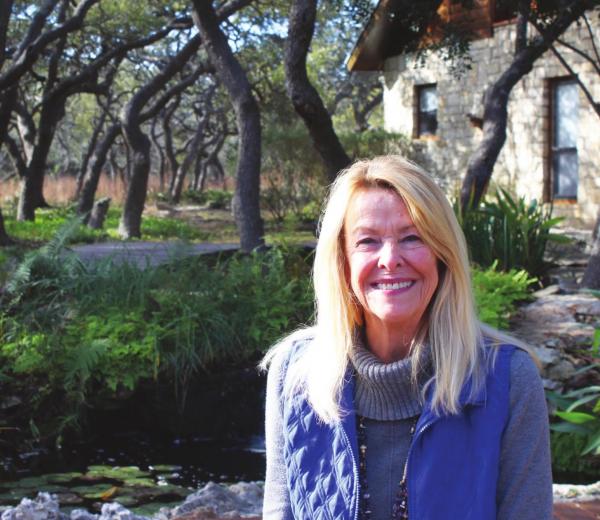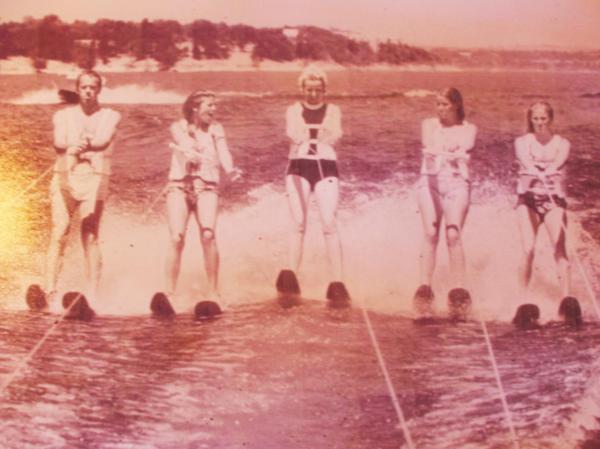The life of an ASTRONAUT’S DAUGHTER
This is the first of a twopart series that recounts the memories and experiences of Juliana Shepard Jenkins, the daughter of astronaut Alan Shepard.
“We just called him daddy,” says Wimberley resident Juliana Shepard Jenkins.
By the way, “daddy” was a test pilot, the first American to be launched into space, hit a couple golf balls on the surface of the moon, retired from the Navy as a rear admiral, has a ship named after him and was a successful businessman. Daddy was astronaut Alan Shepard. A true American hero.
Julie, as she is known, has lived in Wimberley for almost 30 years. She speaks to groups about her experiences as the child of a famous spaceman and helps with fundraising for the Astronaut Scholarship Foundation, a group started by her father and devoted to supporting students in science and mathematics.
The walls of her home — where she lives with her husband Greg Jenkins, a former builder — are covered with reminders of her father’s illustrious career. There are photos of Alan Shepard getting a medal from John F. Kennedy, shaking hands with Lyndon Johnson and meeting Richard Nixon. There is an autographed picture of comedian Bob Hope and singer Bing Crosby dressed as astronauts. The inscription reads: “We’re ready to go.”
Julie’s childhood was certainly not typical. She spent most of her time at boarding schools because her father was moving from base to base, from assignment to assignment. “Some years I probably only saw him 10 days a year,” Julie remembers. “It was my mother (Louise) who kept the family together.”
Julie and her two sisters attended dinners at the White House and a famous photograph of the family water skiing appeared on the pages of Life magazine. The family spent a lot of time in Houston, the headquarters for the National Aeronautics and Space Administration (NASA). They fell in love with Texas and had a vacation home in Lakeway, near Austin. When Julie and Greg married almost 30 years ago, they settled in Wimberley.
Time at sea
In the decade before Julie was born, Alan Shepard already had put together a remarkable resume. He graduated from the U.S. Naval Academy in 1941, just in time for World War II. He had always wanted to be an aviator, but the Navy required young Annapolis graduates to serve time at sea.
He was assigned to the destroyer USS Cogswell. That ship was responsible for rescuing more than 170 sailors from a cruiser that had been torpedoed. The Cogswell was caught in a deadly typhoon and later fought off kamikaze pilots at the Battle of Okinawa. The ship was in Tokyo Bay when the Japanese surrendered in 1945.
During a leave in 1945 he married Louise and started their family.
Julie says her father always loved flying. He would hang around the airport near his home in New Hampshire, doing odd jobs in return for a ride in an airplane or an informal flying lesson. The Navy taught him how to fly at bases in Corpus Christi and Pensacola, Fla.
He ended up as a Navy test pilot.
Then the Soviet Union launched the Sputnik satellite, an event that rocked this country. President Eisenhower established NASA and the space race was on. Alan Shepard was among the first seven “Mercury” astronauts selected from hundreds of hopefuls. Others included names that have earned a place in history: John Glenn, Gus Grissom, Gordon Cooper, Scott Carpenter, Deke Slayton, Wally Schirra.
“They were all a team. The original seven (astronauts) were all very close,” says Julie. “But they were also in competition with one another. My father was a very competitive man.”
Non-stop training
The astronauts went through rigorous medical and physical testing. “They tested for everything, including what they called the vomit machine,” recalls Julie. “He would come home and just sit there and stare sometimes.
“Mother was a trooper. She was with him the whole way.”
What the family wasn’t prepared for was being thrust into the public spotlight. Julie remembers waking up one day, looking out the window and seeing their lawn, sidewalk and street jammed with reporters, photographers and camera crews. “We couldn’t get out of the house,” she says. “We were totally locked in our house.”
When they would go to a restaurant people would come up to shake Shepard’s hand or ask if they could take a photo with him. Initially, he would be annoyed. “My mother had to teach him he was part of something bigger now and had an obligation. He got used to it,” Julie says.
With a test pilot for a husband and father, the family knew all about danger. But being hurled into space in a cramped capsule atop a fuel-filled rocket was something new and unknown. “As a family we have a very strong faith. We didn’t express fear. I have never been afraid. Worried, yes. But never afraid,” says Julie.
When the Soviets sent a man into space, the U.S. reacted quickly. An official at NASA lined up the seven astronauts and snapped: “Shepard, you are first. Grissom, you are next. Glenn you are back up.” Then he turned and marched out. “On the surface he felt for the other astronauts, but underneath he was proud to be first,” says Julie.
Quick comeback
Shepard went home, slipped his arms around his wife’s waist and announced that he was going to be the first man to go into space. Louise’s snappy comeback: “Did someone let a Russian in here?”
Julie recalls her father leaving for the launch in 1961 and her sister nonchalantly saying: “Daddy, have a nice flight.”
Julie remembers sitting crosslegged on the floor watching the spectacle on a black and white TV. What was supposed to be a 15-minute flight stretched into a four-hour wait due to technical problems. Shepard had had a few cups of coffee that morning and had not expected to sit in the capsule for hours. His “nature calls ordeal” led to changes in the design of the space suit to handle such emergencies.
The flight itself went smoothly and Shepard was successfully plucked from the Atlantic Ocean by helicopter. He immediately became a national figure.
After the flight, reporters asked Shepard what he was think ing about while waiting in the cramped capsule. His response: “The fact that every part of this ship was built by the lowest bidder.”
Louise and Alan were welcomed to the White House by President Kennedy and his wife Jackie (the girls didn’t go). Kennedy fumbled a little trying to pin a medal to Shepard. “My father and the president got along well. My mother and Jackie got along good. They were the same type of couple.”
There were parades and ceremonies all over the country. The Shepard family was in demand.
“My mother kept us very level. Daddy didn’t do it for the glory and all the stuff that goes with it,” says Julie. “We knew it was daddy’s job and he had to do it.”
(Next week: To the moon and back and the later years)





